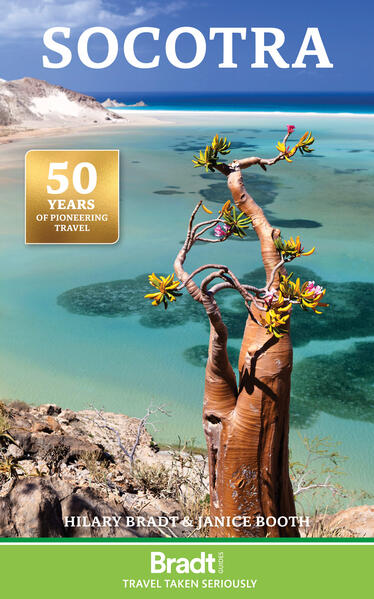Bücher versandkostenfrei*100 Tage RückgaberechtAbholung in der Wunschfiliale

Zustellung: Sa, 11.04. - Mi, 15.04.26
Noch nicht erschienen
VersandkostenfreiBestellen & in Filiale abholen:
The new, thoroughly updated second edition of Bradt s Socotra remains the first and only guide available to the largest of the four islands that make up the Socotra Archipelago in the Arabian Sea, 240 miles offshore from their mother land, Yemen. A UNESCO World Natural Heritage Site packed with dramatically varied and essentially undisturbed landscapes (mountains, forest, ravines, sand-dunes, beaches, caves ), Socotra is unique. Sometimes known as `The Galapagos of the Indian Ocean , the archipelago has an exceptionally large number of species found nowhere else in the world (`endemic ) in an area smaller than Rhode Island. Accordingly, wildlife-watchers love Socotra: of 220 bird species recorded, 11 are endemic, while more than 300 plant species are endemic, as are all the land snails, 90% of reptiles and about 60% of spiders. Socotra offers much to fascinate the adventurous traveller. Visitors may snorkel from boats or pristine beaches; camel-trek into mountains formed by volcanic activity; gawp at bizarre plants dragon blood trees that resemble huge, fuzzy-topped umbrellas and giant desert roses; engage with Socotra's rich history, which stretches back to the Stone Age and includes ancient cave art; and lunch at delightful fishing villages. Bradt s full-colour guide covers everything needed for a successful visit, including pre-departure planning, getting there, tour operators, where to stay and what to see. Background information on history, people, language and culture is followed by an easy-to-follow geographical breakdown covering all parts of the island, from the capital Hadiboh to Ayhaft Canyon National Park, Qaria lagoon, Rosh Marine Nature Sanctuary, Homhil Nature Sanctuary, Terbak village, Hoq Cave, Qalansiyah, Diksam plateau and Firmihin Forest. To preserve its fragile environments, the recent growth in tourism enabled by recent improvements in transport links and resulting in expansion of tourist infrastructure is being handled with extreme care. Strict regulations are in force to preserve the island's natural heritage and nearly three-quarters has protected status. This pristine and relatively unknown little island, so full of natural treasures, may be on the brink of a very different future. Responsible tourism is paramount, so let Bradt s Socotra be your guide to this captivating island.
Warnhinweise
Dieser Hinweis kann lt. Artikel 9 Absatz 7 Satz 2 der GPSR entfallen, da das Produkt auch ohne Anweisungen und Sicherheitsinformationen sicher und wie vom Hersteller vorgesehen verwendet werden kann.
Produktdetails
Erscheinungsdatum
06. Dezember 2024
Sprache
englisch
Auflage
2 Revised edition
Seitenanzahl
192
Reihe
Bradt Travel Guide
Autor/Autorin
Hilary Bradt, Janice Booth
Verlag/Hersteller
Produktart
kartoniert
Gewicht
280 g
Größe (L/B/H)
212/133/9 mm
ISBN
9781804692240
Entdecken Sie mehr
Bewertungen
0 Bewertungen
Es wurden noch keine Bewertungen abgegeben. Schreiben Sie die erste Bewertung zu "Socotra" und helfen Sie damit anderen bei der Kaufentscheidung.









